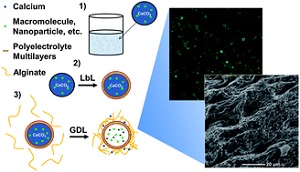 |
| Alginate hydrogel delivery system--Courtesy of Texas A&M |
A new delivery system from Texas A&M University uses a hydrogel material to hold drugs and deliver them through microscopic holes in its structure.
The team of researchers embedded alginate, a material that is common in the cell walls of brown algae, with clusters of calcium carbonate nanoparticles. These nanoparticles are specifically formed around particles--in the future, these could be drugs or imaging material--and the layers of the polymer around the particles control their release.
"Hydrogels constructed with uncoated CaCO3 microspheres release their contents into the surrounding environment, while those constructed with poly electrolyte multilayer-coated CaCO3 microspheres retain the materials within the pores," the scientists wrote in their abstract. "… The ability to encapsulate an assortment of functional materials within a moldable, biocompatible alginate matrix gives this approach great flexibility and potential in a wide variety of biomedical applications."
So like tiny bubbles in a can of seltzer, the micropores in the hydrogel can sustain for a period of time until they burst--but these ones burst in a way that the scientists can control.
"Through chemistry, we can design these microcapsules so that what we put inside of them stays inside of them or what we put inside of them is released when we want it to be released--all at once or gradually," lead researcher Michael McShane said in a statement. "… It's the combination of controlling the gelation, and then controlling how the microcapsules function that makes this a unique and viable system for a variety of applications."
- here's the BioNewsTexas story
- and here's the abstract